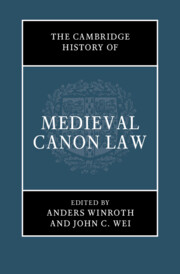Book contents
- The Cambridge History of Medieval Canon Law
- The Cambridge History of Medieval Canon Law
- Copyright page
- Contents
- Figures
- Maps
- Tables
- Contributors
- Acknowledgments
- Abbreviations
- Medieval Canon Law: Introduction
- Part I The History of Medieval Canon Law
- 1 The Early Church
- 2 Early Medieval Canon Law
- 3 Canon Law in the Long Tenth Century, 900–1050
- 4 The Age of Reforms: Canon Law in the Century before Gratian
- 5 The Reinvention of Canon Law in the High Middle Ages
- 6 Canon Law in a Time of Renewal, 1130–1234
- 7 The Late Middle Ages: Four Remarks Regarding the Present State of Research
- 8 The Late Middle Ages: Sources
- 9 The Canon Law of the Eastern Churches
- Part II The Sources and Dissemination of Medieval Canon Law
- Part III Doctrine and Society
- Bibliography of Primary Sources
- Index
- References
2 - Early Medieval Canon Law
from Part I - The History of Medieval Canon Law
Published online by Cambridge University Press: 13 January 2022
- The Cambridge History of Medieval Canon Law
- The Cambridge History of Medieval Canon Law
- Copyright page
- Contents
- Figures
- Maps
- Tables
- Contributors
- Acknowledgments
- Abbreviations
- Medieval Canon Law: Introduction
- Part I The History of Medieval Canon Law
- 1 The Early Church
- 2 Early Medieval Canon Law
- 3 Canon Law in the Long Tenth Century, 900–1050
- 4 The Age of Reforms: Canon Law in the Century before Gratian
- 5 The Reinvention of Canon Law in the High Middle Ages
- 6 Canon Law in a Time of Renewal, 1130–1234
- 7 The Late Middle Ages: Four Remarks Regarding the Present State of Research
- 8 The Late Middle Ages: Sources
- 9 The Canon Law of the Eastern Churches
- Part II The Sources and Dissemination of Medieval Canon Law
- Part III Doctrine and Society
- Bibliography of Primary Sources
- Index
- References
Summary
Between the fourth and tenth centuries, across most of western Europe, law, legal institutions, and legal procedures became Christianized, in the sense that Christian rhetorical tropes, ideologies, and existential perspectives infused legal expression and practices. Royal and imperial courts were sites for interweaving secular and ecclesiastical authority, and hence for interweaving secular and ecclesiastical law. Such interweaving found voice in “mixed assemblies,” that is, assemblies in which both higher clergy and secular nobility participated in judicial and legislative processes; documents issued under the name of a king or emperor also show the integration of secular and ecclesiastical law. Law was not exclusively developed and implemented at royal courts and assemblies: complementing governmental efforts to instantiate Christian law, the educated elite took an interest in law, both as a subject for study and as a resource for informing arbitration, prosecution, or defense of rights and privileges. One of the many streams of legal formation was the practice of collecting, compiling, and conserving decrees and judicial opinions that would, in time, constitute the core of the canon law of subsequent centuries.
- Type
- Chapter
- Information
- The Cambridge History of Medieval Canon Law , pp. 32 - 45Publisher: Cambridge University PressPrint publication year: 2022

